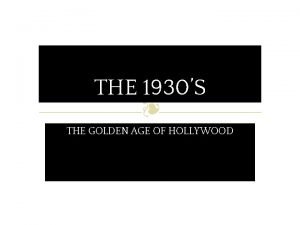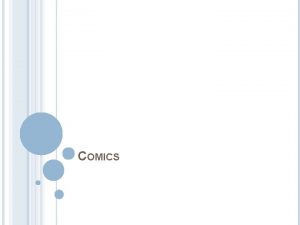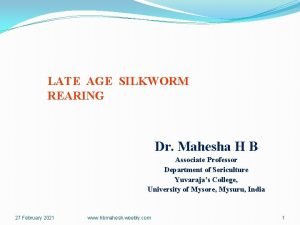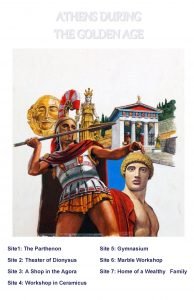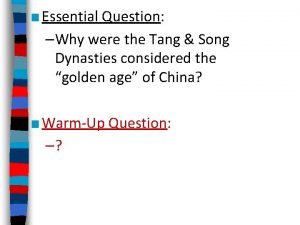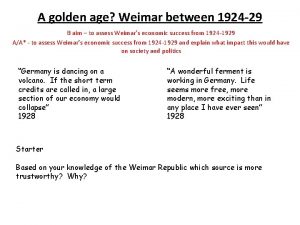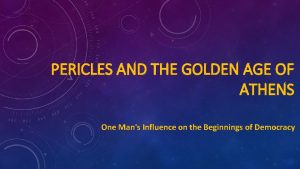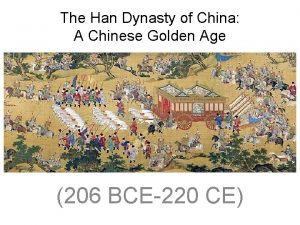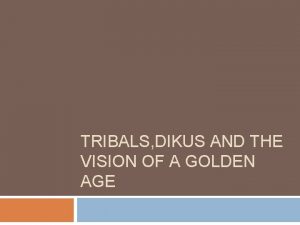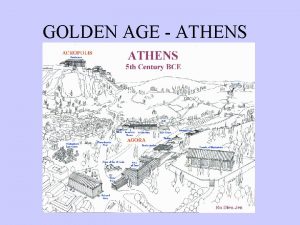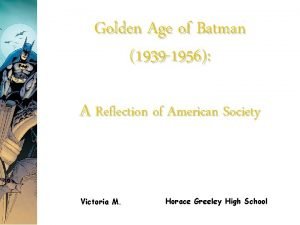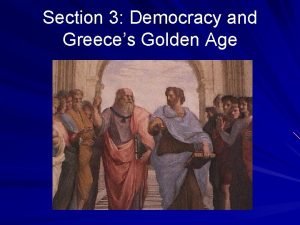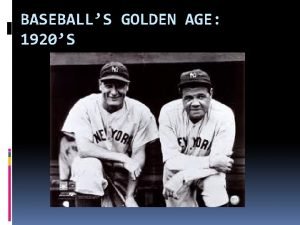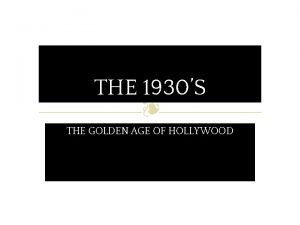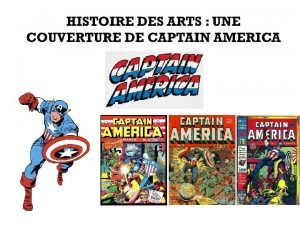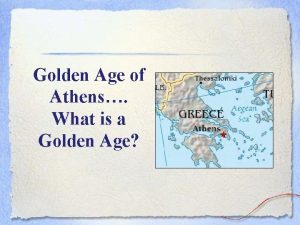The Golden Age of Comics 1930s to late
















![Jack Kirby (August 28, 1917 – February 6, 1994), [2] born Jacob Kurtzberg, was Jack Kirby (August 28, 1917 – February 6, 1994), [2] born Jacob Kurtzberg, was](https://slidetodoc.com/presentation_image/055a69382f1b146f6b23ee3a947734fc/image-17.jpg)
























- Slides: 41

The Golden Age of Comics 1930’s to late 40’s or early 50’s

• During the Golden Age, modern comic books were first published and enjoyed a surge of popularity; the archetype of the superhero was created and defined; and many of the most famous superheroes debuted, among them Superman, Batman, Captain America, Wonder Woman, and Captain Marvel. Read On to Find Out More…

The Golden Age Hawkman, from Flash Comics # 71 (May 1946). Art by Joe Kubert.

Namor's first cover appearance: Marvel Mystery Comics #4 (Feb. 1940). Art by Alex Schomburg.

• • • In Batman's first appearance in Detective Comics #27, he is already operating as a crime fighter. Batman's origin is first presented in Detective Comics #33 (November 1939), and is later fleshed out in Batman #47. As these comics state, Bruce Wayne is born to Dr. Thomas Wayne and his wife Martha, two very wealthy and charitable Gotham City socialites. Bruce is brought up in Wayne Manor, with its wealthy splendor, and leads a happy and privileged existence until the age of eight, when his parents are killed by a small-time criminal named Joe Chill while on their way home from a movie theater. Bruce Wayne swears an oath to rid the city of the evil that had taken his parents' lives. He engages in intense intellectual and physical training; however, he realizes that these skills alone would not be enough. "Criminals are a superstitious cowardly lot, " Wayne remarks, "so my disguise must be able to strike terror into their hearts. I must be a creature of the night, black, terrible. . . " As if responding to his desires, a bat suddenly flies through the window, inspiring Bruce to take on the persona of Batman. In early strips, Batman's career as a vigilante earns him the ire of the police. During this period Wayne has a fiancée named Julie Madison. Wayne takes in an orphaned circus acrobat, Dick Grayson, who becomes his sidekick, Robin. Batman also becomes a founding member of the Justice Society of America, although he, like Superman, is an honorary member, and thus only participates occasionally. Batman's relationship with the law thaws quickly, and he is made an honorary member of Gotham City's police department. During this time, butler Alfred Pennyworth arrives at Wayne Manor, and after deducing the Dynamic Duo's secret identities joins their service. Batman

Batman made his debut in Detective Comics #27 (May 1939) – cover art by Bob Kane

• • • Extraordinary powers and abilities, relevant skills and/or advanced equipment. A strong moral code, including a willingness to risk one's own safety in the service of good without expectation of reward. Such a code often includes a refusal or strong reluctance to kill or wield lethal weapons. A motivation, such as a sense of responsibility, a formal calling, a personal vendetta against criminals, or a strong belief in justice and humanitarian service. A secret identity A distinctive costume An underlying motif or theme that affects the hero's name, costume, personal effects, and other aspects of his or her character. A supporting cast of recurring characters, including the hero's friends, co-workers and/or love interests, who may or may not know of the superhero's secret identity. Often the hero's personal relationships are complicated by this dual life. A number of enemies that he/she fights repeatedly. Independent wealth A headquarters or base of operations, usually kept hidden from the general public A backstory that explains the circumstances by which the character acquired his or her abilities as well as his or her motivation for becoming a superhero. Many origin stories involve tragic elements and/or freak accidents that result in the development of the hero's abilities. The Superhero Archetype (Model)

The Golden Age Aquaman communicating with sea life by an ancient Atlantean temple he uses as his lair, from More Fun Comics #83 (Nov. 1942). Art by Louis Cazeneuve.

• Publishing of comic books became a major industry. The period also saw the emergence of the comic book as a mainstream art form, and the defining of the medium's artistic vocabulary and creative conventions by its first generation of writers, artists, and editors. History

Marvel Mystery Comics #9 (July 1940): Fire vs. water in comics' first major crossover. Cover art by Bill Everett.

Action Comics is an American comic book series that introduced Superman, the first major superhero character as the term is popularly defined. The publisher was originally known as Detective Comics, Inc. , and later as National Comics and as National Periodical Publications, before taking on its current name of DC Comics. Timely Comics, an imprint of Timely Publications, was the earliest comic book arm of American publisher Martin Goodman, and the entity that would evolve by the 1960 s to become Marvel Comics.

• • Golden Age In her debut in All Star Comics #8, Diana was a part of a tribe of female women named the Amazons, native to Paradise Island- a secluded island set in the middle of a vast ocean. Captain Steve Trevor's plane crashes on the island he is found alive by Diana and a fellow Amazon. Diana has him nursed back to help and falls in love with him. Her mother, the Queen of the Amazons Hippolyte holds a competition among all the Amazons to decide who is the most worthy of all the women. The winner would then be given the chance of delivering Captain Steve Trevor back to man's world and fight for freedom and liberty. Diana enters the competition wearing a mask to conceal her identity, as her mother forbids her to enter the competition. She wins the competition and then reveals her identity. The winner nevertheless, she is chosen to take Steve Trevor back and is awarded a special dress made by her mother for her new role as Wonder Woman. When she came to America for the first time, Wonder Woman came upon a weeping army nurse named Diana Prince. The nurse wanted to leave for South America with her fiancé but was unable to due shortage of money. As both of them looked identical and Wonder Woman needed a job and identity to monitor on Steve, who was admitted in the same army hospital, she gave her the money she had earned earlier to help her go to her fiancé in exchange of her credentials. Thus, Diana's secret identity of Diana Prince was created and she started to work as an army nurse. Wonder Woman then took part in a variety of adventures, mostly side by side with Trevor. Her most common foes during that period would be Nazi forces, and sometimes villains like Baroness Paula Von Gunther, The Cheetah, Doctor Psycho and Duke of Deception. Wonder Woman

Wonder Woman's first cover, Sensation Comics #1 (January 1942)

• One event cited for the beginning of the Golden Age was the 1938 debut of Superman in Action Comics #1, published by a predecessor of modern-day DC Comics. Superman's creation made comic books into a major industry. • Between early 1939 and late 1941, DC and sister company All. American Publications introduced such popular superheroes as Batman and Robin, Wonder Woman, The Flash, Green Lantern, the Atom, Hawkman, and Aquaman, while Timely Comics, the 1940 s predecessor of Marvel Comics, had millionselling titles that featured the Human Torch, the Sub-Mariner, and Captain America. History

Charles Clarence Beck (June 8, 1910 – November 22, 1989) was an American cartoonist and comic book artist, best known for his work on Captain Marvel at Fawcett Comics and DC Comics.

Whiz Comics #2 (February 1940), the first appearance of Captain Marvel. Cover art by C. C. Beck. Whiz Comics #22 (Oct. 1941), featuring Captain Marvel and his young alter-ego, Billy Batson.
![Jack Kirby August 28 1917 February 6 1994 2 born Jacob Kurtzberg was Jack Kirby (August 28, 1917 – February 6, 1994), [2] born Jacob Kurtzberg, was](https://slidetodoc.com/presentation_image/055a69382f1b146f6b23ee3a947734fc/image-17.jpg)
Jack Kirby (August 28, 1917 – February 6, 1994), [2] born Jacob Kurtzberg, was an American comic book artist, writer and editor regarded by historians and fans as one of the major innovators and most influential creators in the comic book medium.

• Although DC and Timely characters are more famous today, circulation figures suggest that the best-selling superhero title of the era may have been Fawcett Comics' Captain Marvel, whose approximately 1. 4 million copies per issue made it "the most widely circulated comic book in America. " Captain Marvel's sales soundly trounced Superman's self-titled series and Action Comics alike, and the comic at one point was issued biweekly to capitalize upon that popular interest. History

Superman making his debut in Action Comics No. 1 (June 1938); Cover art by Joe Shuster Jerry Siegel and Joe Shuster had initially created a bald telepathic villain bent on dominating the world, in the short story "The Reign of the Super-Man" in Science Fiction #3, a fanzine Siegel published in 1933. [


Superman #14 (February 1942). Cover art by Fred Ray

Powerhouse Pepper #2 (May 1948). Cover art by Basil Wolverton.

• Other popular and long-running characters included Quality Comics' Plastic Man, and cartoonist Will Eisner's non-superpowered masked detective the Spirit, originally published as a syndicated Sunday-newspaper insert in a quasi-comic book format. History

All Star Comics is a 1940 s comic book series from All-American Publications, one of the early companies that merged with National Periodical Publications to form the modern-day DC Comics. With the exception of the first two issues, All Star Comics primarily told stories about the adventures of the Justice Society of America. The series is notable for its introduction of the Justice Society of America, the first team of superheroes, and the introduction of Wonder Woman.

Marvel Comics #1 (Oct. 1939), the first comic book from Marvel predecessor Timely Comics. Cover art by Frank R. Paul.

• Although the superhero was the Golden Age's most significant contribution to pop culture, many genres appeared on the newsstands, including humor, Western, romance, and jungle stories. • The licensed Walt Disney animated character comics actually outsold all the supermen of the day. • Dell Comics, featuring such licensed movie and literary properties as Mickey Mouse, Donald Duck, Roy Rogers, and Tarzan, boasted circulations of over two million copies a month, and Donald Duck writer-artist Carl Barks is considered one of the era's major talents. History


Donald Duck “Lost in the Andes” 1949

Donald Duck “Lost in the Andes” 1949

Carl Barks (March 27, 1901 – August 25, 2000) was an American cartoonist. He worked for the Disney Studio and created Duckburg and many of its inhabitants, such as Scrooge Mc. Duck (1947), Gladstone Gander (1948), the Beagle Boys (1951), The Junior Woodchucks (1951), Gyro Gearloose (1952), Cornelius Coot (1952), Flintheart Glomgold (1956), John D. Rockerduck (1961) and Magica De Spell (1961). The quality of his scripts and drawings earned him the nicknames The Duck Man and The Good Duck Artist. Writer-artist Will Eisner called him "the Hans Christian Andersen of comic books. "[1]

War and Comics

• World War II and the subsequent era in history following the dropping of the atomic bomb in 1945, impacted the content and subject matter of comic books in the Golden Age. One example is the educational comic book Dagwood Splits the Atom, using characters from the comic strip Blondie. Superheroes with nuclear-derived powers began to emerge, such as the Atomic Thunderbolt and Atoman. In the movie serial Atom Man vs. Superman, the hero fought a villain named Atom Man, while Superman's weakness to kryptonite recalled the dangers of atomic radiation. In contrast to the serious, atomic funny animal characters such as Atomic Mouse and Atomic Rabbit were developed as well to possibly help ease young readers' fears over the prospect of nuclear war. During this time the heroes began to fight communists, and some got involved in the Korean War as well. War Affects Comics


• Comic books, particularly superhero comics, gained immense popularity during the war as cheap, portable, easily read tales of good triumphing over evil. American comic book companies showcased their heroes battling the Axis Powers: covers featuring superheroes punching Nazi leader Adolf Hitler, such as Captain America #1 by Timely comics in 1941, or fighting buck-toothed caricatures of Japanese soldiers. http: //marvel. com/digitalcomics/view. htm? iid=1652

• http: //www. dailymotion. com/video/x 7 x 2 kx_1950 -atomman-vs-superman-chp 1_shortfilms

• • • During their adventures, Franklin D. Roosevelt presents Captain America with a new shield, forged from an alloy of steel and vibranium, fused by an unknown catalyst, so effective that it replaces his own firearm. Throughout World War II, Captain America and Bucky fight the Nazi menace both on their own and as members of the superhero team the Invaders (as seen in the 1970 s comic of the same name). Captain America also battles a number of criminal menaces on American soil, including a wide variety of costumed villains: the Wax Man, the Hangman, the Fang, the Black Talon, and the White Death, among others. In late April 1945, during the closing days of World War II, Captain America and Bucky try to stop the villainous Baron Zemo from destroying an experimental drone plane. Zemo launches the plane with an armed explosive on it, Rogers and Barnes in hot pursuit. The pair reach the plane just before take off. When Bucky tries to defuse the bomb, it explodes in mid -air. The young man is believed killed. Rogers is hurled into the freezing waters of the North Atlantic. Neither is found, and both are presumed dead. It is later revealed that neither character actually died. Captain America continued to appear in comics for the next few years changing from World War II-era hero fighting against the Nazis to trying to defeat the United States' newest enemy, Communism. Captain America

http: //www. youtube. com/watch? v=6 FU 6 vvz. Kv. Q

Green Lantern's debut in All. American Comics#16 (July 1940). Art by Sheldon Moldoff.

End of the Era

• 1940 s comics were called Golden Age by 1963, as on the cover of Strange Tales #114 (November 1963). • As World War II ended the popularity of the superhero comics diminished, and in an effort to retain readers comic publishers began diversifying more than ever into war, Western, science fiction, romance, crime and horror comics. As a result, many superheroes titles were canceled.

All-Star Western was the name of three American comic book series published by DC Comics, each a Western fiction omnibus featuring both continuing characters and anthological stories. The first ran from 1951 to 1961, the second from 1970 to 1972 and the third is part of The New 52 released in September 2011.
 Golden age of hollywood 1930s
Golden age of hollywood 1930s The golden age of comics
The golden age of comics Types of comics
Types of comics Platinum age of comics
Platinum age of comics Iron age dates
Iron age dates Iron age bronze age stone age timeline
Iron age bronze age stone age timeline Most convenient method of silkworm bed cleaning is
Most convenient method of silkworm bed cleaning is Dali sacrament of the last supper golden ratio
Dali sacrament of the last supper golden ratio Golden ratio and golden rectangle
Golden ratio and golden rectangle 1930 computers
1930 computers Entertainment in 1930s
Entertainment in 1930s Aggressive actions taken in the 1920s and 1930s
Aggressive actions taken in the 1920s and 1930s Dust bowl 1930s
Dust bowl 1930s The hollywood studio system in the 1930s and 1940s
The hollywood studio system in the 1930s and 1940s Athens during the golden age
Athens during the golden age Persian empire golden age
Persian empire golden age The golden age chapter 7
The golden age chapter 7 Golden age of the roman empire
Golden age of the roman empire Golden age greek mythology
Golden age greek mythology The tang and song eras were a golden age of
The tang and song eras were a golden age of The golden age of weimar
The golden age of weimar Pericles and the golden age of athens
Pericles and the golden age of athens Golden age of greece drama
Golden age of greece drama India's golden age
India's golden age The tang and song eras were a golden age of
The tang and song eras were a golden age of What are the key achievements from the islamic golden age
What are the key achievements from the islamic golden age Medieval japan art
Medieval japan art Han dynasty golden age
Han dynasty golden age Prosternida
Prosternida Tribals dikus and the vision of a golden age
Tribals dikus and the vision of a golden age Weimar golden age
Weimar golden age During the golden age of athens, a tribute was
During the golden age of athens, a tribute was Heian-kyo the heart of japan's golden age
Heian-kyo the heart of japan's golden age The golden age (1939-1956)
The golden age (1939-1956) Chinas dynastys
Chinas dynastys The golden age of greece
The golden age of greece World history patterns of interaction
World history patterns of interaction Golden age of the roman empire
Golden age of the roman empire The golden age of russian literature
The golden age of russian literature Democracy and greece's golden age
Democracy and greece's golden age What was the golden age
What was the golden age Age of history
Age of history
